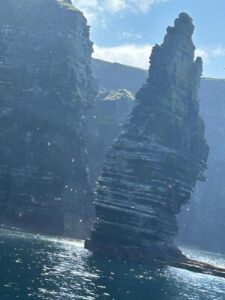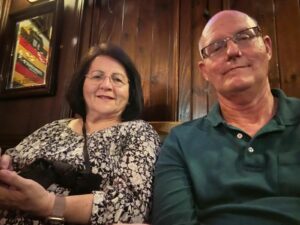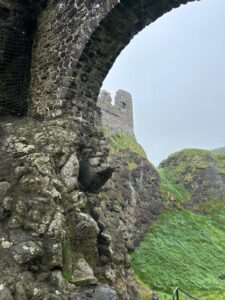Ireland and England Journal by John and Jan Oakes
We are traveling to Ireland and England, as well as visiting churches in Dublin, Belfast and London. I will be keeping a journal of our travels here.
Journal for Ireland and England May, 2024
Ireland May 15-22
Jan and I arrive in Dublin Wednesday evening. While in Dublin we are staying at the Auld Dubliner, which is actually a raucous tourist bar in the center of town. Our first evening we enjoy a night on the town, having local food and listening to live music at three different locations. It was great fun.
Ireland is a country of eight million, whose population in 1840 was greater than it is today. There is a sadness to the history of this beautiful island due to the dual tragedies of the conquest of Ireland by England and the infamous potato famine in the 1840s. Yet, Ireland has a beautiful and colorful history. In the eighth through eleventh centuries, Ireland was the intellectual and spiritual capital of Western Christianity. One of our goals while here is to get in touch with that deep history.
While in Dublin, we are blessed to spend time with Paul and Jacqui Smith, who lead our small church here in the Dublin area. They were hired just a year ago to oversee this group, which has been dispersed widely in central Ireland.
In Dublin we experience the local food (particularly Irish stew and, of course, fish and chips), as well as visiting Trinity College, with its wonderful library, the National Museum of Ireland, with an amazing archaeological display and the Chester Beaty Museum, where the largest collection of second and third century New Testament manuscript collection in the world is housed.
On Friday we traveled by bus to Belfast. We cross from the Republic of Ireland to Northern Ireland, which is part of the United Kingdom. The border is interesting, as there is literally no actual border. We just keep driving. This is a unique experience. Belfast is a prosperous city of about a half million, with a very sad history of sectarian violence between the Protestant Royalists and the Catholic Republicans. The city is divided by high walls euphemistically called “peace walls” into Catholic and Protestant sections. These walls were created by British soldiers during the 30 “years of trouble,” which finally ended in 1998, when the IRA ended its campaign of bombings.
Here we are blessed to spend time with Simon Dinning, who leads a church of about fifty here in Belfast. He is both a teacher and an evangelist. We have a lot in common.
On Saturday we travel to Londonderry, which is known to the locals as Derry. They do so for good reason. This is the most Catholic of cities in Northern Ireland. It has a populationof 110,000. Derry was the epicenter of the ethnic violence during the thirty years of “troubles” before the Good Friday agreement of 1998. It became a fully Republican area, as the Protestant population was, essentially, driven out by intimidation and violence. That it is a Catholic/Republican area is made clear by the political murals all over the city.
The drive to Derry is magnificent, as we travel through the idyllic, green countryside, with seemingly infinite sheep, cattle and ancient stone-built houses. We visit Dunluce Castle, on a high promontory over the sea. The ruins are spectacular. We also visit the Giants Causeway, a natural wonder of hexagonal or pentagonal-shaped basalt columns. It is hard to describe the beauty of these columns, right on the Irish Sea. We also visit the “dark hedges,” We have no idea where they got this name, but they are wonderful, other-worldly rows of trees, leading up to an estate, which are famous for their use in the mini-series Game of Thrones. From there, we travel to the city of Derry, where we are introduced to the city by a guide who lived through the terrible times in this ancient city. The city has been around since at least the sixth century AD, and is surrounded by a still-intact wall.
On Sunday we leave Northern Ireland to travel to Gallway, on the West coast of the Island. We first stop at a very interesting round fort-like structure which has been around (pun intended) since about 300 BC. It is at the top of a high hill, with a view for many miles around. Its use is a mystery—was it for religious purposes, a fort, a stadium for sporting events, or perhaps all three? It was used as a hide-out and meeting place by the IRA during the time when Ireland separated from the UK. Coming down the coast, we stop at, of all things, a little beach-side town, famous for its surfing. From there, we come into the bustling port-town of Gallway. It has dozens of churches, but it seems that few if any of them are currently in use. After all, this is Sunday. On the other hand, there seems to be no shortage of pubs and restaurants, with a very active night life. This seems to be a pattern in Ireland.
 Cliffs of Moher
Cliffs of Moher
On Monday we headed down the “Wild Atlantic Coast,” from Gallway to the Dingle Peninsula in the southwest of Ireland. We spent time at the Cliffs of Moher, which are one of the most photographed sites in the world. The cliffs are 700 feet high and make for a spectacular view from the sea. We stop along the coast, visiting rock formations which are formed from fossils more than 300 million years old. We take a passenger ferry across the Shannon River Estuary, driving down to the Dingle Peninsula. This is one of the few remaining areas where Irish is the principal language of the home. The area is so beautiful. Thankfully, there are no malls, McDonalds or Starbucks here, and the people are very friendly.
Tuesday we spend the day on Dingle Peninsula, which is one of the most strikingly beautiful places in the world. We head out to Slea Head, at the tip of the peninsula for spectacular views of the islands, the sheep pastures, the clear, blue-green water and the sheer cliffs. It cannot be described, but most be seen. We spend time in the little city of Dingle, visiting its beautiful cathedral, walking among its very colorful houses. This is a tourist city, but also a fishing village. From there, we spend time at Inch Beach, and travel inland to Killarney to spend time in the Killarney National Park. The mountains, lakes and the natural beauty are amazing.
Wednesday is our last in Ireland. We stop at the Blarney Castle, one purpose of which is to kiss the Blarney Stone. The story if its ability to give one the gift of gab is a load of blarney, but the castle and associated gardens are a great visit. From there, we drive back to Dublin for one last evening on the town. Tonight the final of the Europe Cup (football aka soccer( is happening in Dublin. The pubs are very busy. It is great to feel a part of the life of a Dubliner, if just for a bit. We are sad to leave the Emerald Isle.
London May 24-26
We are spending four days in London, mainly doing teaching for the church here. This is at least my fifth visit to teach for churches in the London area. I love almost everything English—except the weather. London is one of the great cosmopolitan cities, with a population right around ten million. It is the home of great universities, great museums, great culture, great sports, and great food (as long as it isn’t English food). On Thursday AM we fly from Dublin to London and spend the day with Mulligan and Jo Price, who lead the West Region of the London Church of Christ. He is from Manchester and she is from Durban, South Africa. It is a delight sharing our vision of serving God and his people together. After a wonderful English lunch (I exaggerated the poor quality of English food a bit), we spend time with Mohann and Helen Nanjudan, who are former leaders of the London Church of Christ, after which I teach a lesson on “A Defense of the Christian Worldview.”
Church in London.
From there, we drive with James Thomas to the South of London. We are staying with him and his wife Amanda. He leads the teaching ministry here. One purpose of our visit is to help support the teaching ministries in London. On Friday we climb Box Hill, which is a famous scene from the novel Emma by Jane Austin. We also visit the site of the Epsom spring, where “Epsom Salts” were first discovered. Saturday includes breakfast with Andrew and Rhoda Agerback. They are good friends of 20+ years and are pillars in the church here in the UK. After, I give a four hour class on Church History for the South region of the London Church of Christ. There are about 60 at the class and at least 50 on line. Afterward we have a wonderful lunch with the leadership team, including the leaders of the region, Franklin and Nadine Walters.
Sunday is a combined church service for the London Church. We meet in a Quaker hall, with perhaps 600 or so there. The diversity and range of age is encouraging. I preach from Paul’s farewell address in Acts 20, after which we get a bit of a tour of London. Fish and chips in the evening and we are ready for our next adventure tomorrow.
May 27-31 The Lake District, England
On Monday we drive to Ambleside, a town on lake Windemere in the Lake District of England. The area is absolutely gorgeous. This is the most famous resort area of England, and the home of the great poets like Byron and Wordsworth, as well as of Beatrix Potter. We are here simply to relax and enjoy. Tuesday includes a hike up a 3000-foot peak Hellvellyn.
Wednesday we traveled to the home of the famous children’s author Beatrix Potter. This is one of the most famous sites in the Lake District. The drive there and back is quite treacherous, through fantastically narrow streets, with high rock and hedge walls. We also visited the ruins of the large Roman fort in Ambleside. In the evening, we travel north to Keswick, past many lakes, to this resort town for a dinner of very English food.
Thursday we travel West to the seaside at Ravenglass. This tiny village is on the wind-swept coast. We see almost no tourists here, so it gives a feel of the locals. On the way we spend several hours at a wonderfully preserved Muncaster Castle, with some spectacular gardens. In the late afternoon we stroll the seaside, and experience a wonderful sunset over the bay of Ravenglass.
London June 1-3
Friday we drive back to London for our last three days. We are staying in the Watford area with our good friends Malcolm and Penny Cox, who lead a church here in Watford. Malcolm has served as an evangelist and teacher for more than thirty years.
Saturday is very full, as I teach a lesson on the role of the Holy Spirit in the Christian life to the North Region of the London Church of Christ for two hours, followed by a two hour lesson in Central London for the campus group on the question of suffering. This group has a lot of really hard questions. It is refreshing to see young students who are thinking deeply about the most important questions. After this, James Thomas (the same as earlier!) takes us on a tour of Central London to see Covent Garden, Big Ben, Picadilly Square, Parliament, #10 Downing Street and more. Great fun!
Our last day includes meeting with the Watford Church for worship. I teach in the blessings of living in Christ to this group, followed by a run through the hills and parks of this quaint town on the edge of London. Monday morning Jan and I say good-bye to our friends, refreshed and ready to get back into the work of the gospel in Merced, California. Thanks to the many who sponsored and encouraged us on our way.
John and Jan Oakes 6/3/2024

















































